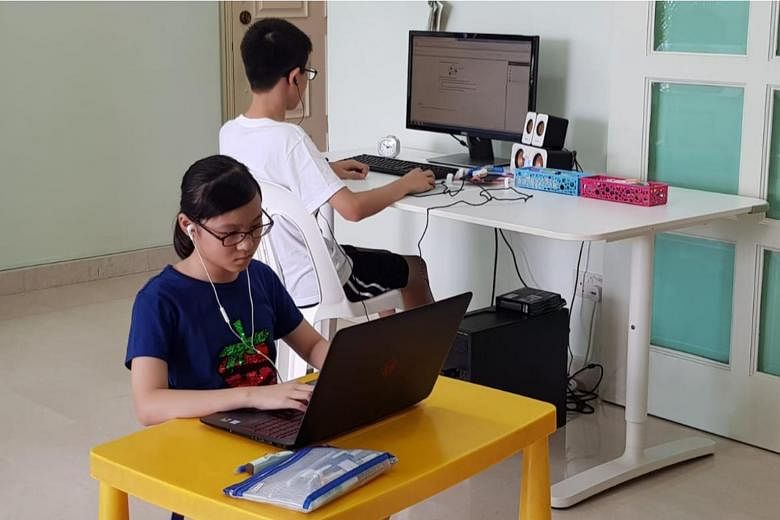Ask parents and teachers how full remote learning, which started on April 8 and ends today, was and the answer is likely to be more good than bad.
From frayed tempers to periods of enlightenment, the adults whom The Straits Times interviewed said they ran the whole gamut of emotions during the one month of home-based learning.
Parents were glad to have more time with their children, even as they struggled to balance home-based learning with working from home and finding personal time for themselves.
They also said home-based learning was largely effective and worked especially well for older children who did not need much hand holding.
A dipstick survey of parents by the Education Ministry (MOE) found that about seven in 10 were satisfied with how home-based learning was conducted by their children's schools.
Parents have also given feedback that it is useful to create routines for younger children, such as drawing up a timetable and setting ground rules, an MOE spokesman told ST.
Madam Priscilla Yeow, who has a Secondary 2 son and Primary 6 daughter, said: "The live videoconferencing sessions were most effective in delivering key concepts, as the platform allowed for more interaction and engagement with teachers and friends.
"The kids were also more disciplined when the teacher was watching them online."
Added the 44-year-old, who works at a clinic: "I didn't need to sit beside them, unlike my friends with younger kids. I positioned the computer and laptop in the living and dining area too, and peeked at their screens occasionally to ensure they're doing work."
For students, about six in 10 said they were able to cope well, said the MOE spokesman. Some liked home-based learning as they could learn at their own pace.
Eight in 10 said they were looking forward to schools reopening and resuming their learning in classrooms with their teachers and peers.
Ms Kartina Rosli, 46, said her Secondary 2 daughter took a week or so to get used to home-based learning.
"In the first week, she asked me several times for help - if her answers were correct, if I could give her some ideas for compositions," added the mother of two, who has been running her public relations and digital agency from home.
"But after that, I told her she has to act as if she's attending school and cannot ask me for help."
With her seven-year-old son, who has autism, Ms Kartina spent about an hour with him in the mornings working on his numeracy and literacy activities.
Ms Kathleen Goy said her Primary 4 daughter learnt to be more independent and disciplined.
"Class actually started at 9am, but by 8am, she was logged on to her online platform to finish early to have more time for other activities."
Still, the 39-year-old, who works in marketing and events, said home-based learning cannot match face-to-face interaction.
Housewife Grace Tang, 38, who has a Primary 3 daughter, had a similar view. "Home-based learning takes away part of the two-way communication between teachers and students, which is effective for learning. It is hard for teachers to gauge a student's learning ability and understanding."
Home-based learning may be more effective for independent and conscientious learners, she added.
"Otherwise, school is still the best place for children to have meaningful conversations and relationships with their peers and teachers."
Ms Irene Lum, a counsellor with a Secondary 2 daughter, added that students who do not have a conducive learning environment at home may have found it tough.
"I can see how students with mental and emotional needs may not get the help needed if home-based learning is prolonged, so perhaps this needs to be reviewed and worked on," said Ms Lum, 45.
Architect Wendy Koh, 39, who has a Primary 4 daughter, suggested having a common chatbox on the Singapore Student Learning Space to resolve issues more efficiently, without teachers having to individually respond to messages.
Some parents said navigating different platforms was challenging.
Housewife Claire Chan, 40, whose two sons are in Primary 3 and Kindergarten 2, said: "It is a full-time job just to keep track of the things the kids need to do by checking multiple platforms or notification sections and cross-checking."
Ms Goy said it has been challenging for her to manage her two girls, aged five and 10. "I snapped at them a few times because they kept asking me to play,"she added.
Still, parents said they appreciated having more quality time with their children.
Ms Jacinda Liu, 35, who has a Primary 4 son and Primary 3 daughter, saw a different side to her children.
"I enjoyed walking past my son during his live lessons and seeing him make crazy faces.
"It was only a month out of our children's more than a decade long academic experience so parents should reframe their perspective."











